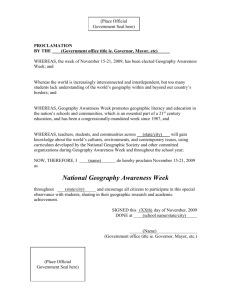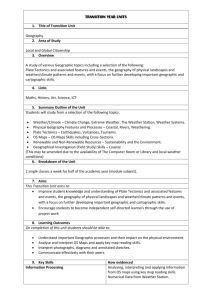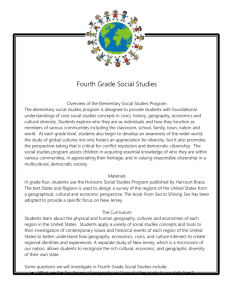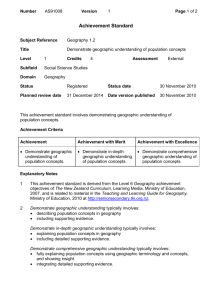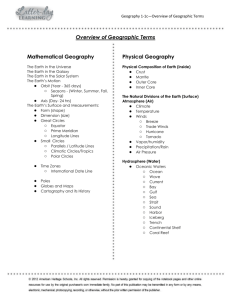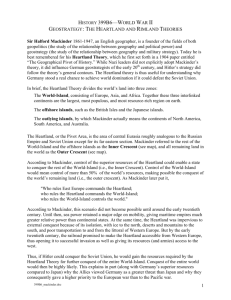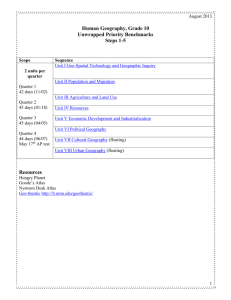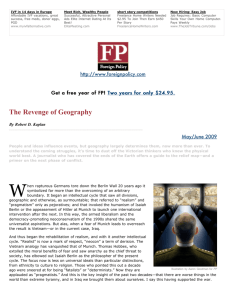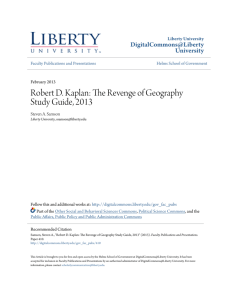Bishop Lynch High School World Geography – Dr. Iden Political
advertisement
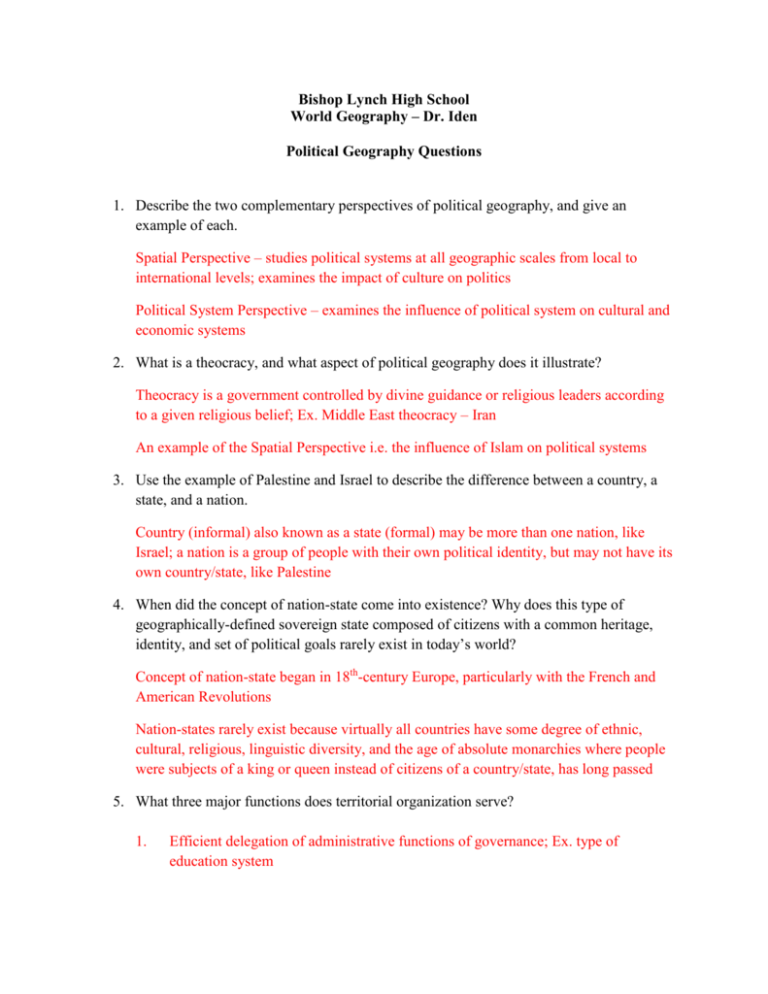
Bishop Lynch High School World Geography – Dr. Iden Political Geography Questions 1. Describe the two complementary perspectives of political geography, and give an example of each. Spatial Perspective – studies political systems at all geographic scales from local to international levels; examines the impact of culture on politics Political System Perspective – examines the influence of political system on cultural and economic systems 2. What is a theocracy, and what aspect of political geography does it illustrate? Theocracy is a government controlled by divine guidance or religious leaders according to a given religious belief; Ex. Middle East theocracy – Iran An example of the Spatial Perspective i.e. the influence of Islam on political systems 3. Use the example of Palestine and Israel to describe the difference between a country, a state, and a nation. Country (informal) also known as a state (formal) may be more than one nation, like Israel; a nation is a group of people with their own political identity, but may not have its own country/state, like Palestine 4. When did the concept of nation-state come into existence? Why does this type of geographically-defined sovereign state composed of citizens with a common heritage, identity, and set of political goals rarely exist in today’s world? Concept of nation-state began in 18th-century Europe, particularly with the French and American Revolutions Nation-states rarely exist because virtually all countries have some degree of ethnic, cultural, religious, linguistic diversity, and the age of absolute monarchies where people were subjects of a king or queen instead of citizens of a country/state, has long passed 5. What three major functions does territorial organization serve? 1. Efficient delegation of administrative functions of governance; Ex. type of education system 2. 3. Resource allocation through local agencies attuned to needs of the people; Ex. how education system is funded Delegation of local governance autonomy, Ex. collection of taxes to support education system 6. What is the difference between a federal system and a unitary system of government? Federal - Local territories/units are given varying degrees of self-governance/autonomy; Ex. – U.S., Canada, Mexico Unitary – No self-governance/autonomy granted local territories/units; Ex. - Egypt, Iran, Cuba, Myanmar 7. Explain how the 2000 U.S. presidential election reflects the political implications of geographic organization under a federal political system. Geographic organization with locally governed states, provinces, etc. can affect the outcome of elections, like the presidential election of 2000 where Al Gore won the popular vote (aggregate votes cast in all states), but George W. Bush won the electoral vote and the presidency based on votes by electors (chosen from each state in proportion to the state’s population); Reapportionment and redistricting shifts political power as centers of population and demographic distribution such as urban/rural, age, gender, ethnicity cause geographic political boundaries to change 8. Briefly describe and give an example of each of the following types of states: a. Microstate – tiny countries with limited resources; Ex. Vatican City, San Marino b. Fragmented state – countries with pieces, typically islands; Ex. Fiji c. Elongated state – thinly stretched countries; Ex. Chile d. Rectangular state – geometrically rectangular; Ex. Angola e. Compact state – countries with rounded shapes; Ex. Poland f. Perforated state – countries that surround other smaller states; Ex. Italy g. Prorupted state – countries with a thin peninsula jutting out; Ex. Thailand h. Enclaves – small, relatively homogeneous region surrounded by a larger, different region; Ex. Lesotho, Swaziland i. Exclaves – territory of a country that lies within the boundary of another country; Ex. West Berlin, Kalingrad j. Landlocked – country completely surrounded by other countries; Ex. Nepal 9. Compare and contrast different the types of physical boundaries (geometric, subsequent, antecendent, superimposed, relic) in chart format. Geometric Subsequent Antecedent Superimposed Relic Follow straight lines, not natural landscape or culture regions Established after population has settled in geographic areas respecting cultural, social, ethnic characteristics Boundaries are assigned to a region before it is settled Established after population has settled with disregard to cultural, social, ethnic characteristics Border that no longer exists but has cultural, historical, political, or economic implications 10. Describe the two forces that work within countries to pull them apart as well as bind them together. What role does Balkanization play in either of these processes? Centrifugal – forces that pull countries apart and creates conflict – can be positive ultimately, but usually negative; Ex. Soviet Union, Bosnia & Herzigovina Centripetal – forces that bind countries together – can also be positive (usually), or negative 11. Under what circumstances could centripetal forces become destructive? In cases of extreme nationalism, Ex. Nazi Germany, Iran, centripetal forces can become destructive 12. Identify the meaning of the term frontier, and give two examples. An area where borders are shifting and weak, and different countries are laying claim to the territory; Ex. western Amazon Basin, Antarctica 13. What is a buffer state? Country that occupies the space between two larger, oppositional countries; Ex. 14. What is the Law of the Sea? When was it enacted, and what was it designed to do? Law of the Sea was passed in 1983 to resolve disputes over coastal areas (12 nautical mile restriction) and economic rights (200 nautical miles) 15. Discuss why colonialism is considered to be the single-most important geopolitical phenomenon of the past 500 years. Include in your discussion the impact of the concepts of imperialism and self-determination. Colonialism has led to competition and conflict for territory since ancient times. Rome, Greece, and the Aztecs were some of the first colonial powers, and were followed later by Portugal, Spain, Britain, France, Sweden, Russia, Austria, China, and Japan have all been colonial powers. Even though colonialism was swept away in the 20th century, imperialism, or one country dominating another culturally or economically, remains to this day, and even the United States is considered a dominant imperial power because of the global influence it exerts. Vestiges of colonialism remain a problem in countries of Africa, Asia, and South America even though they are independent, and long-term conflict and even civil war has resulted. But some imperial powers do allow territorial possessions a degree of self-determination, or self-rule, and minimize conflict, such as the U.S. and Puerto Rico. 16. List and describe the three early theories of international political geography. Organic Theory (Friedrich Ratzel & Rudolf Kjellen) – countries must expand to grow and thrive; theory abandoned after Hitler’s lebensraum theory led to World War II Heartland Theory (Sir Halford Mackinder) – believed that Eurasia is the geographical pivot and that whoever dominates this land mass dominates the world Rimland Theory (Nicholas Spykman) – refuted Mackinder’s Heartland Theory by asserting that the countries surrounding the heartland were the most important world political players 17. Identify and state the purpose of the following international organizations: a. United Nations (UN) – most nations belong; promotes international peace and security; can impose economic and political sanctions b. North American Free Trade Agreement (NAFTA) – regional organization linking U.S., Mexico, and Canada; promotes economic development through reduced border restrictions and trade agreements c. Organization of Petroleum Exporting Countries (OPEC) – oil producing countries in Middle East, South America, and Southeast Asia belong; an economic alliance focused on production, exportation, supply, and price of oil d. North Atlantic Treaty Organization (NATO) – 28 North American and European nations belong; primary purpose is military security 18. How do organizations like the European Union and the Commonwealth of Independent States differ from international organizations? EU is a supranational organization which means members must be willing to relinquish a certain amount of sovereignty to belong Commonwealth of Independent States is a confederation that functions for a common purpose, much like international organizations 19. Briefly explain the east/west divide, the domino theory, and the north/south divide. East/West Divide – Ideological battle - communism vs. capitalism; countries in close proximity to USSR might become communist Domino Theory – in east/west divide, theory that fall of other countries to communism would tip the scales of world power North/South – Economic battle, haves (Northern Hemisphere) vs. Have Nots (Southern Hemisphere); Asia, Africa, Latin America trying to overcome historic colonial dominance, and the poverty, instability that occurred after becoming independent 20. What particular issue has moved to the top of the international policy discussion agenda in recent years? Why is it such an important issue, and why are universal laws related to this issue so difficult to enforce? Regulation of environmental problems such as ozone depletion, biodiversity loss, climate change Core, or advanced, countries are greatest contributors to these and other environmental problems which makes passing and enforcing international laws very difficult. Either the Periphery, or developing countries, see it as hypocrisy to have restrictions placed on their developing economies (India, China) when the Core countries (U.S. in particular) have built their economies as the result of minimal environmental restrictions, and Core countries (again, the U.S. in particular) see stringent international environmental standards as not only unrealistic but unnecessarily punitive toward the U.S.



